check oil GEELY CK 2008 Service Manual
[x] Cancel search | Manufacturer: GEELY, Model Year: 2008, Model line: CK, Model: GEELY CK 2008Pages: 392, PDF Size: 38.86 MB
Page 286 of 392
![GEELY CK 2008 Service Manual 279 4 DTC 00283, 00285,00287, 00290 Like ly Cause s
[De s cription]
When there is recognized open
or short circuit in the sensor, this DTC is set.
[Hint]
The likely c ause ma y be the poor
c onn GEELY CK 2008 Service Manual 279 4 DTC 00283, 00285,00287, 00290 Like ly Cause s
[De s cription]
When there is recognized open
or short circuit in the sensor, this DTC is set.
[Hint]
The likely c ause ma y be the poor
c onn](/img/58/57159/w960_57159-285.png)
279 4 DTC 00283, 00285,00287, 00290 Like ly Cause s
[De s cription]
When there is recognized open
or short circuit in the sensor, this DTC is set.
[Hint]
The likely c ause ma y be the poor
c onne ction of the sensor, short circ uit in the coil
or wire ha rne ss, or fault in the se nsor signa l
proce ssing c irc uit in the ABS ECU�z Ope n c irc uit in the se nsor c onne ctor or coil
�z Short circuit in the sensor coil
�z The se nsor c onne ctor or wire harne ss is short to
ground or powe r supply
�z Fault in the sensor signal processing circuit in the
ABS ECURepair the connectorCheck the sensor on each wheelRemove the ABS ECU connector, check
whether the resistances among the following
terminals is within the specification?
Standard:
1.0~1.3K
LF: 1-2K
RF: 19-20K
LR: 5-6K
RR: 22-23K Check the corresponding sensor connectorDoes the fault reoccur?Check the wire harness between the ECU and
the sensor Refer to "Occasional Prob-
lem Service Key Points"Replace the ABS ECU
Abn.
Abn. Normal
Normal
Normal
Ye s Normal Ω,
Ω,
Ω,
Ω,
Ω,
Page 299 of 392
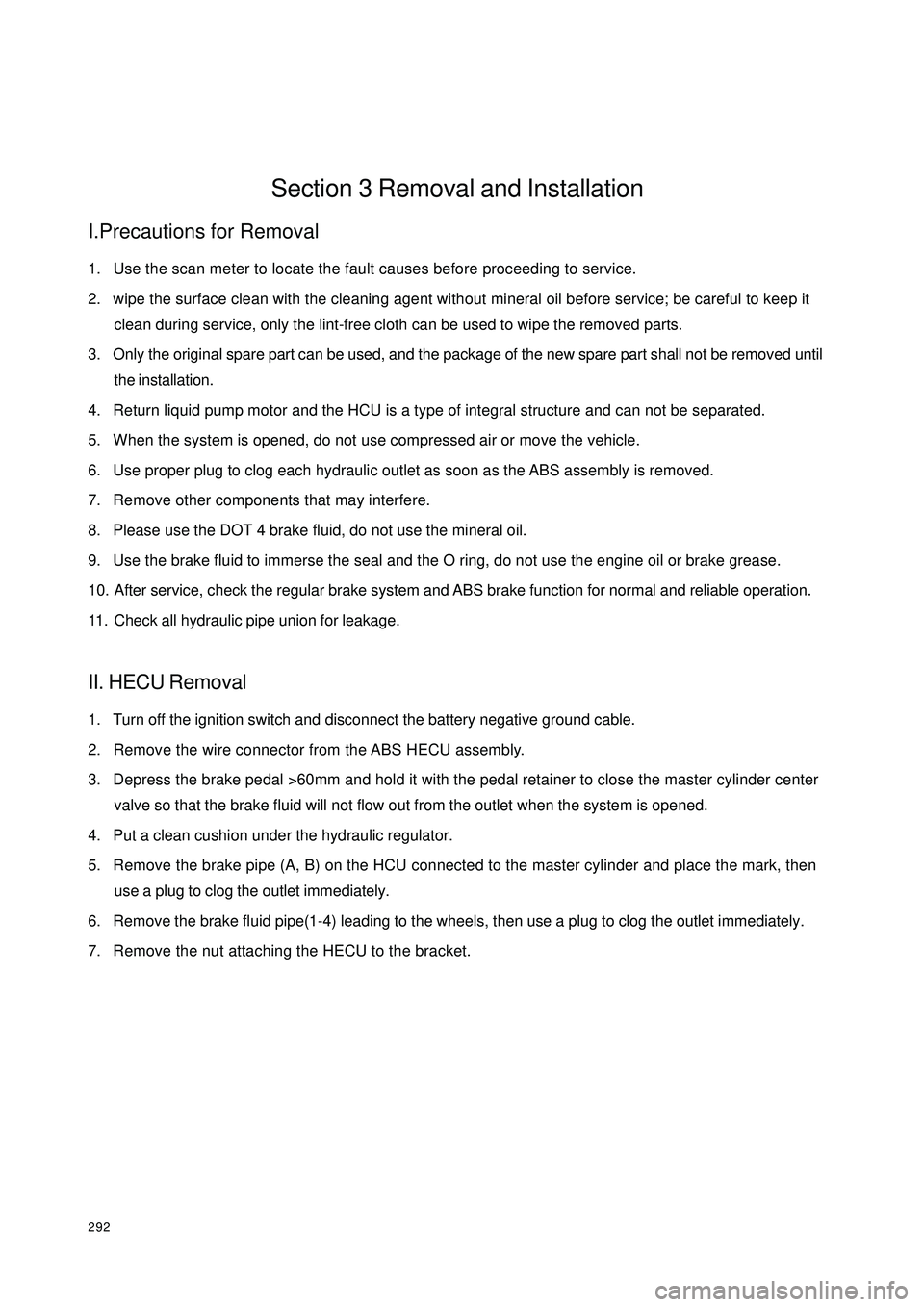
292Section 3 Removal and InstallationI.Precautions for Removal1. Use the scan meter to locate the fault causes before proceeding to service.
2. wipe the surface clean with the cleaning agent without mineral oil before service; be careful to keep it
clean during service, only the lint-free cloth can be used to wipe the removed parts.
3. Only the original spare part can be used, and the package of the new spare part shall not be removed until
the installation.
4. Return liquid pump motor and the HCU is a type of integral structure and can not be separated.
5. When the system is opened, do not use compressed air or move the vehicle.
6. Use proper plug to clog each hydraulic outlet as soon as the ABS assembly is removed.
7. Remove other components that may interfere.
8. Please use the DOT 4 brake fluid, do not use the mineral oil.
9. Use the brake fluid to immerse the seal and the O ring, do not use the engine oil or brake grease.
10. After service, check the regular brake system and ABS brake function for normal and reliable operation.
11. Check all hydraulic pipe union for leakage.II. HECU Removal1. Turn off the ignition switch and disconnect the battery negative ground cable.
2. Remove the wire connector from the ABS HECU assembly.
3. Depress the brake pedal >60mm and hold it with the pedal retainer to close the master cylinder center
valve so that the brake fluid will not flow out from the outlet when the system is opened.
4. Put a clean cushion under the hydraulic regulator.
5. Remove the brake pipe (A, B) on the HCU connected to the master cylinder and place the mark, then
use a plug to clog the outlet immediately.
6. Remove the brake fluid pipe(1-4) leading to the wheels, then use a plug to clog the outlet immediately.
7. Remove the nut attaching the HECU to the bracket.
Page 311 of 392
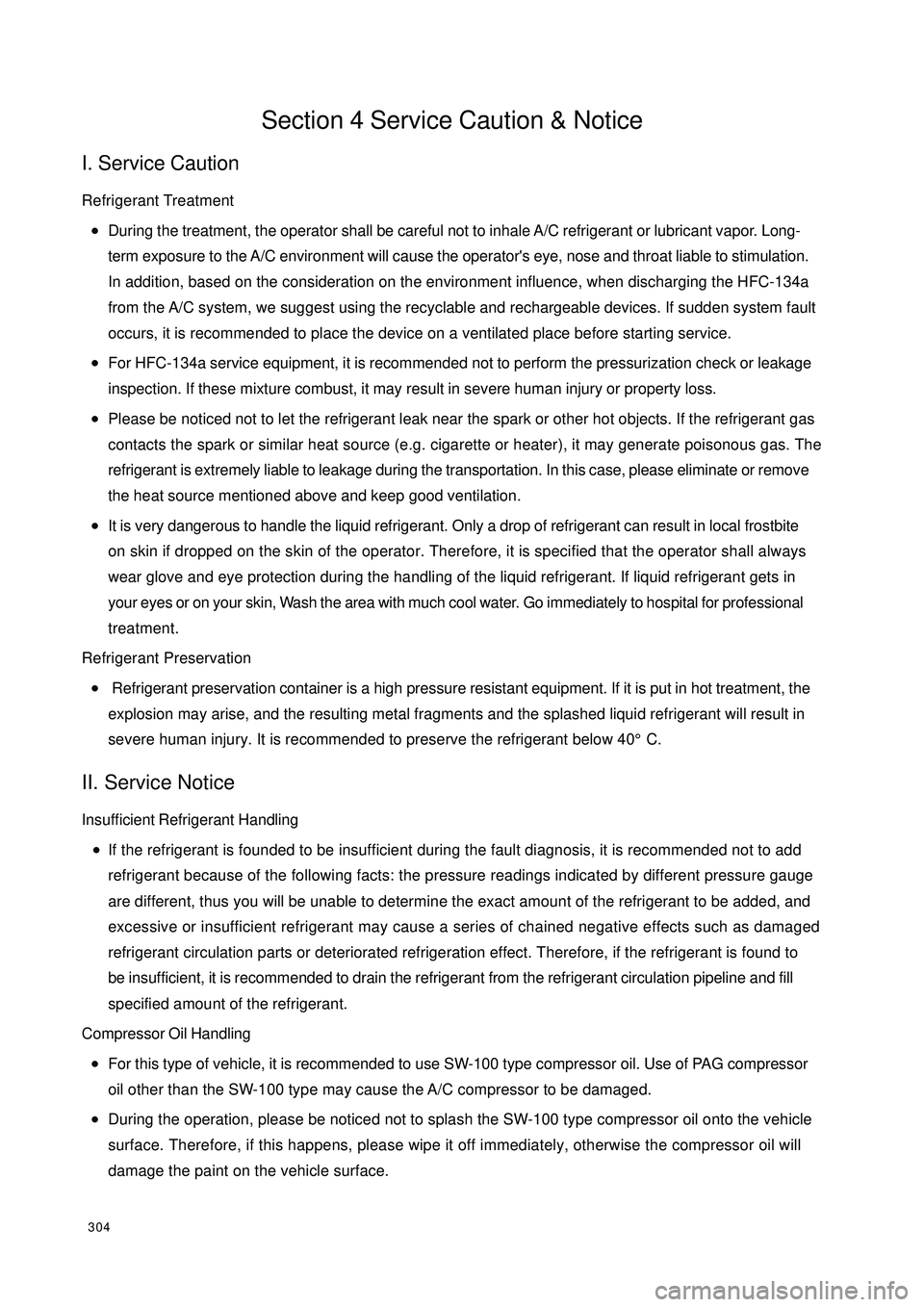
304Section 4 Service Caution & NoticeI. Service CautionRefrigerant Treatment
•During the treatment, the operator shall be careful not to inhale A/C refrigerant or lubricant vapor. Long-
term exposure to the A/C environment will cause the operator's eye, nose and throat liable to stimulation.
In addition, based on the consideration on the environment influence, when discharging the HFC-134a
from the A/C system, we suggest using the recyclable and rechargeable devices. If sudden system fault
occurs, it is recommended to place the device on a ventilated place before starting service.
•For HFC-134a service equipment, it is recommended not to perform the pressurization check or leakage
inspection. If these mixture combust, it may result in severe human injury or property loss.
•Please be noticed not to let the refrigerant leak near the spark or other hot objects. If the refrigerant gas
contacts the spark or similar heat source (e.g. cigarette or heater), it may generate poisonous gas. The
refrigerant is extremely liable to leakage during the transportation. In this case, please eliminate or remove
the heat source mentioned above and keep good ventilation.
•It is very dangerous to handle the liquid refrigerant. Only a drop of refrigerant can result in local frostbite
on skin if dropped on the skin of the operator. Therefore, it is specified that the operator shall always
wear glove and eye protection during the handling of the liquid refrigerant. If liquid refrigerant gets in
your eyes or on your skin, Wash the area with much cool water. Go immediately to hospital for professional
treatment.
Refrigerant Preservation
• Refrigerant preservation container is a high pressure resistant equipment. If it is put in hot treatment, the
explosion may arise, and the resulting metal fragments and the splashed liquid refrigerant will result in
severe human injury. It is recommended to preserve the refrigerant below 40°C.II. Service NoticeInsufficient Refrigerant Handling
•If the refrigerant is founded to be insufficient during the fault diagnosis, it is recommended not to add
refrigerant because of the following facts: the pressure readings indicated by different pressure gauge
are different, thus you will be unable to determine the exact amount of the refrigerant to be added, and
excessive or insufficient refrigerant may cause a series of chained negative effects such as damaged
refrigerant circulation parts or deteriorated refrigeration effect. Therefore, if the refrigerant is found to
be insufficient, it is recommended to drain the refrigerant from the refrigerant circulation pipeline and fill
specified amount of the refrigerant.
Compressor Oil Handling
•For this type of vehicle, it is recommended to use SW-100 type compressor oil. Use of PAG compressor
oil other than the SW-100 type may cause the A/C compressor to be damaged.
•During the operation, please be noticed not to splash the SW-100 type compressor oil onto the vehicle
surface. Therefore, if this happens, please wipe it off immediately, otherwise the compressor oil will
damage the paint on the vehicle surface.
Page 312 of 392
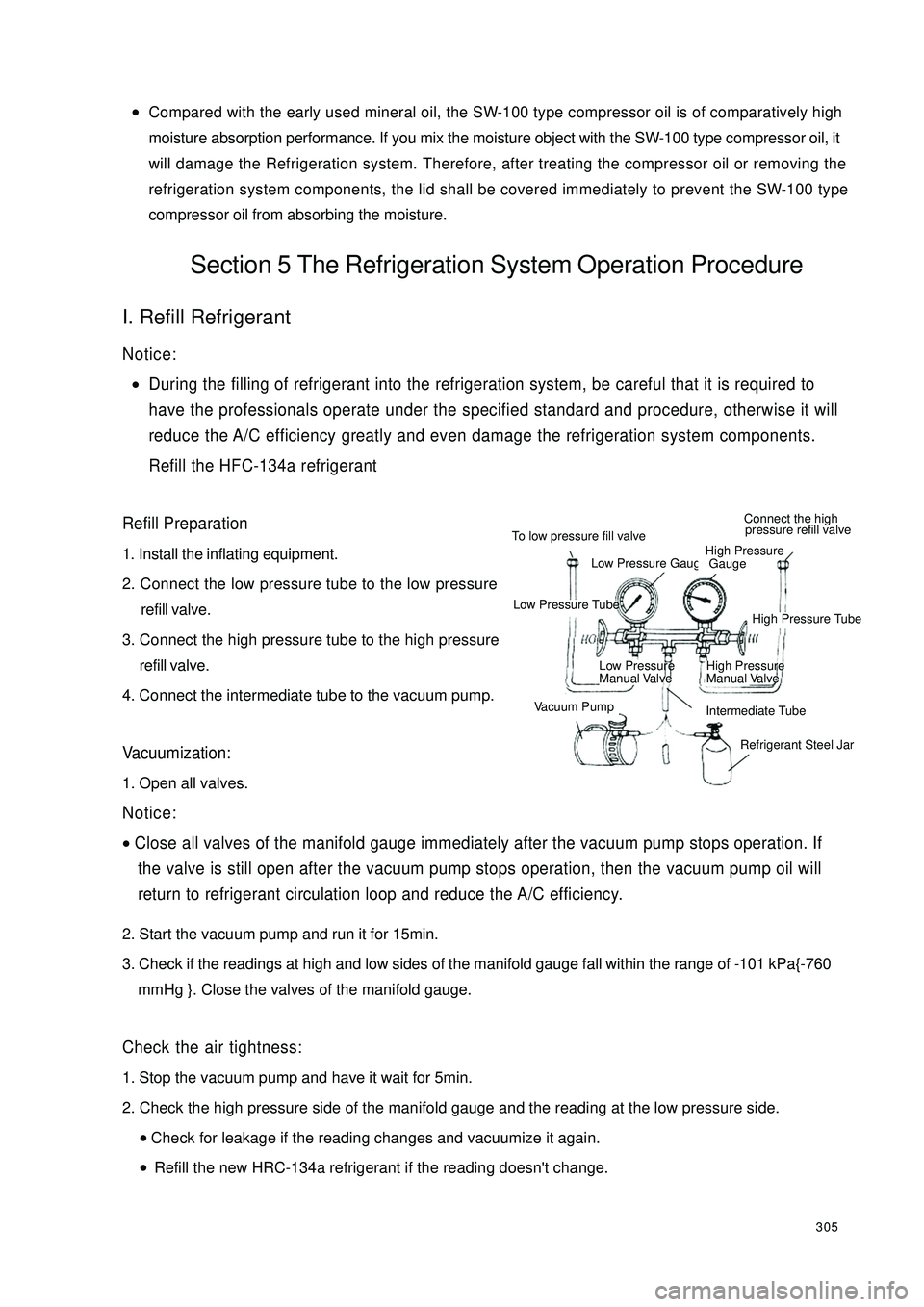
305•Compared with the early used mineral oil, the SW-100 type compressor oil is of comparatively high
moisture absorption performance. If you mix the moisture object with the SW-100 type compressor oil, it
will damage the Refrigeration system. Therefore, after treating the compressor oil or removing the
refrigeration system components, the lid shall be covered immediately to prevent the SW-100 type
compressor oil from absorbing the moisture.Section 5 The Refrigeration System Operation ProcedureI. Refill RefrigerantNotice:•During the filling of refrigerant into the refrigeration system, be careful that it is required to
have the professionals operate under the specified standard and procedure, otherwise it will
reduce the A/C efficiency greatly and even damage the refrigeration system components.
Refill the HFC-134a refrigerant
Refill Preparation1. Install the inflating equipment.
2. Connect the low pressure tube to the low pressure
refill valve.
3. Connect the high pressure tube to the high pressure
refill valve.
4. Connect the intermediate tube to the vacuum pump.Vacuumization:1. Open all valves.Notice:•Close all valves of the manifold gauge immediately after the vacuum pump stops operation. If
the valve is still open after the vacuum pump stops operation, then the vacuum pump oil will
return to refrigerant circulation loop and reduce the A/C efficiency.2. Start the vacuum pump and run it for 15min.
3. Check if the readings at high and low sides of the manifold gauge fall within the range of -101 kPa{-760
mmHg }. Close the valves of the manifold gauge.Check the air tightness:1. Stop the vacuum pump and have it wait for 5min.
2. Check the high pressure side of the manifold gauge and the reading at the low pressure side.
•Check for leakage if the reading changes and vacuumize it again.
•Refill the new HRC-134a refrigerant if the reading doesn't change.To low pressure fill valveLow Pressure GaugeHigh Pressure
GaugeConnect the high
pressure refill valveLow Pressure TubeHigh Pressure TubeLow Pressure
Manual ValveHigh Pressure
Manual ValveVacuum PumpIntermediate Tube
Refrigerant Steel Jar
Page 316 of 392

3095. Remove evaporator.
6. The installation is in the reverse order of the removal.The Evaporator Installation Guide1. Pack certain SW-100 compressor oil into the refrigerant circuit when installing a new evaporator.
Refill: (approximate)
15ml {15 cc, }Check Evaporator1. Remove evaporator.
2. Remove the evaporator core from the evaporator.
3. Check for crack, damage or oil leakage.
•Replace the evaporator core if any of the above-mentioned fault occurs.
4. Check the fin for bending.
•Flat it with a flat head screwdriver if it is bent.Check Heater1. Remove the heater.
2. Remove heating core from the heater.
3. Check for crack, damage or refrigerant leakage.
•Replace the heating core if any of the above-mentioned faults occurs.
4. Check the fin for bending
•Flat it with a flat head screwdriver if it is bent.
5. Check heater inlet hose and outlet hose for bend or damange.
•Repair the hose if necessary.
Page 317 of 392

3104. A/C Compressor Removal / Installation1. Disconnect the negative (--) terminal cable from the battery.
2. Drain the refrigerant from the system.
3. Detach the radiator.
4. Loose the drive belt and then remove the drive belt.Notice:•If anything moisture or any foreign matter enters into the Refrigeration system for circulation,
the cooling performance of the Refrigeration system will obviously deteriorate with abnormal
noise. Plug the port immediately after removing any cooling circulation component to prevent
anything moistur or any foreign matter from entering the circulation.5. Remove the compressor inlet and outlet pipe.
6. Removemagnetic clutch connector.
7. Remove the compressor.
8. The installation is in the reverse order of the removal.
9. Adjust the drive belt.
10. Check the Refrigeration system performance.5. The Condenser Removal / Installation1. Disconnect the negative (--) terminal cable from the battery.
2. Drain the refrigerant from the system.Notice:•If anything moisture or any foreign matter enters into the Refrigeration system for circulation,
the cooling performance of the Refrigeration system will obviously deteriorate with abnormal
noise. Plug the port immediately after removing any cooling circulation component to prevent
anything moistur or any foreign matter from entering the circulation.3. Remove the condenser inlet and outlet pipeline to prevent the compressor oil from splashing.
4. Remove condenser fan connector.
5. Remove the engine hood lock.
6. Remove the engine hood lock support brace.
7. Remove the condenser.
8. The installation is in the reverse order of the removal.
9. Check the Refrigeration system performance.The Condenser Installation Description:1. When installing the new condenser, it is recommended to fill certain SW-100 compressor oil into the
refrigerant circuit.Refill: (approximate)
20ml{20 cc }
Page 318 of 392

311Check the condenser1. Check for crack, damage or oil leakage.
•Replace the condenser if any of the above-mentioned faults occurs.
2. Check if the fin area is blocked by dust.
•Clean it if it is blocked.
3. Check if the fin area bends.
•If the fin area bends, level it with a flat head screwdriver.6. Refrigeration Pipeline Removal / Installation1. Remove battery.
2. Drain the refrigerant from the system.
3. Remove air filter.
4. Remove the clamp.
5. Remove the compressor inlet hose.
6. Remove the compressor outlet hose.
7. Remove liquid pipe I.
8. Remove pressure switch connector.
9. Remove the pipe clamp.
10. Remove liquid pipe II.
11. The installation is in the reverse order of the removal.Notice:•If anything moisture or any foreign matter enters into the Refrigeration system for circulation,
the cooling performance of the Refrigeration system will obviously deteriorate with abnormal
noise. Plug the port immediately after removing any cooling circulation component to prevent
anything moistur or any foreign matter from entering the circulation.
Introduction Of The Refrigeration Pipeline Removal:
Nuts union type:Loose the nuts with 2 wrenches and then remove the refrigeration pipe (or the hose).Slider joint type:Clip the slider block recess end with pliers or the similar tool and remove the attaching bolt or screw cap.
Page 320 of 392
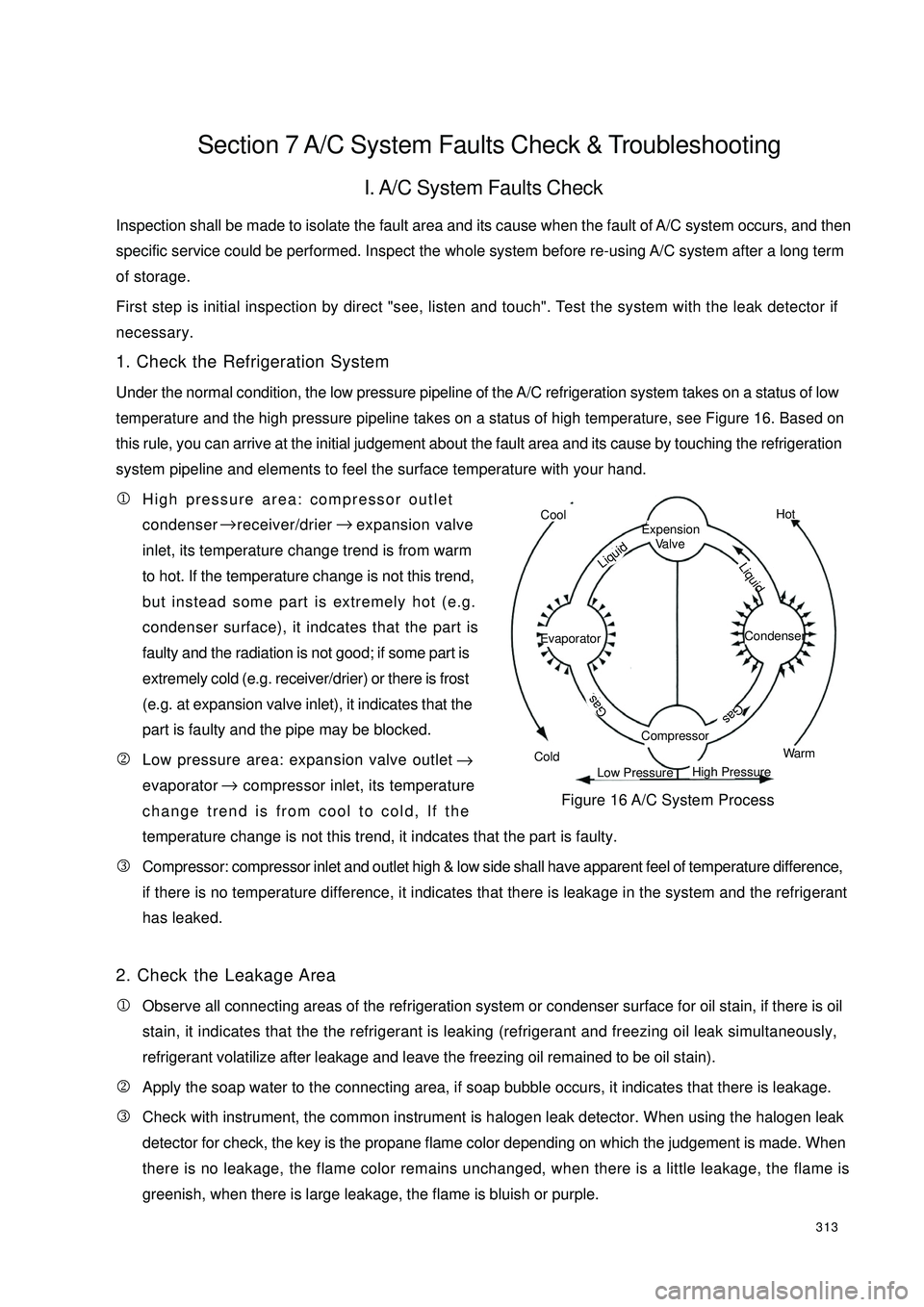
313Section 7 A/C System Faults Check & TroubleshootingI. A/C System Faults CheckInspection shall be made to isolate the fault area and its cause when the fault of A/C system occurs, and then
specific service could be performed. Inspect the whole system before re-using A/C system after a long term
of storage.
First step is initial inspection by direct "see, listen and touch". Test the system with the leak detector if
necessary.
1. Check the Refrigeration System
Under the normal condition, the low pressure pipeline of the A/C refrigeration system takes on a status of lowtemperature and the high pressure pipeline takes on a status of high temperature, see Figure 16. Based onthis rule, you can arrive at the initial judgement about the fault area and its cause by touching the refrigeration
system pipeline and elements to feel the surface temperature with your hand.
1High pressure area: compressor outlet
condenser receiver/drier expansion valve
inlet, its temperature change trend is from warm
to hot. If the temperature change is not this trend,
but instead some part is extremely hot (e.g.
condenser surface), it indcates that the part is
faulty and the radiation is not good; if some part is
extremely cold (e.g. receiver/drier) or there is frost
(e.g. at expansion valve inlet), it indicates that the
part is faulty and the pipe may be blocked.
2Low pressure area: expansion valve outlet
evaporator compressor inlet, its temperature
change trend is from cool to cold, If the
temperature change is not this trend, it indcates that the part is faulty.
3Compressor: compressor inlet and outlet high & low side shall have apparent feel of temperature difference,
if there is no temperature difference, it indicates that there is leakage in the system and the refrigerant
has leaked.
2. Check the Leakage Area
1Observe all connecting areas of the refrigeration system or condenser surface for oil stain, if there is oil
stain, it indicates that the the refrigerant is leaking (refrigerant and freezing oil leak simultaneously,
refrigerant volatilize after leakage and leave the freezing oil remained to be oil stain).
2Apply the soap water to the connecting area, if soap bubble occurs, it indicates that there is leakage.
3Check with instrument, the common instrument is halogen leak detector. When using the halogen leak
detector for check, the key is the propane flame color depending on which the judgement is made. When
there is no leakage, the flame color remains unchanged, when there is a little leakage, the flame is
greenish, when there is large leakage, the flame is bluish or purple.CoolColdHotWarmExpension
Va l v eCompressorEvaporator Condenser Gas
GasLiquid LiquidLow PressureHigh PressureFigure 16 A/C System Process → →
→→
Page 321 of 392
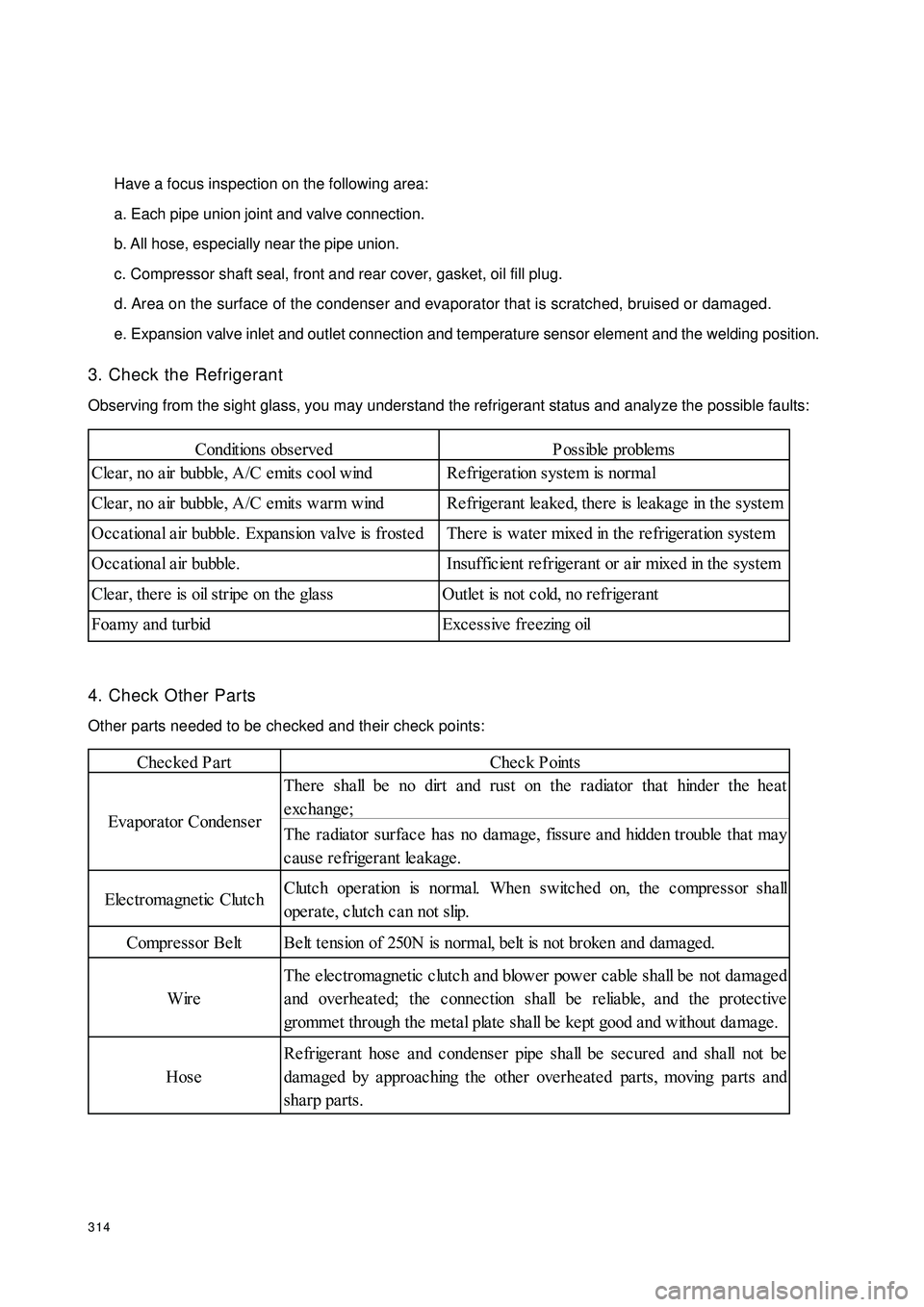
314Have a focus inspection on the following area:
a. Each pipe union joint and valve connection.
b. All hose, especially near the pipe union.
c. Compressor shaft seal, front and rear cover, gasket, oil fill plug.
d. Area on the surface of the condenser and evaporator that is scratched, bruised or damaged.
e. Expansion valve inlet and outlet connection and temperature sensor element and the welding position.
3. Check the Refrigerant
Observing from the sight glass, you may understand the refrigerant status and analyze the possible faults:
4. Check Other Parts
Other parts needed to be checked and their check points:Conditions obse rvedP ossible proble ms
Cle ar, no a ir bubble , A/C e mits c ool wind Re frige ra tion system is normal
Cle ar, no a ir bubble , A/C e mits warm wind Re frige ra nt le a ke d, the re is le aka ge in the syste m
Occ a tiona l a ir bubble . Expa nsion va lve is froste d There is wa te r mixe d in the re frigeration syste m
Occational air bubble. Insufficient refrigerant or air mixed in the system
Cle ar, the re is oil stripe on the gla ss Outle t is not c old, no refrige ra nt
Foamy and turbid Excessive freezing oilChecked PartCheck Points
The re sha ll be no dirt and rust on the radiator tha t hinde r the he at
exchange;
The ra dia tor surfa ce ha s no da mage , fissure a nd hidde n trouble tha t ma y
cause refrigerant leakage.
Elec tromagne tic Clutc hClutc h ope ration is norma l. Whe n switche d on, the c ompre ssor sha ll
operate, clutch can not slip.
Compre ssor Be lt Be lt te nsion of 250N is normal, belt is not broke n and dama ged.
WireThe electromagnetic clutch and blower power cable shall be not damaged
and overheated; the connection shall be reliable, and the protective
gromme t through the me tal plate sha ll be ke pt good a nd without da ma ge .
HoseRefrigerant hose and condenser pipe shall be secured and shall not be
dama ged by a pproac hing the othe r ove rhe ate d pa rts, moving pa rts a nd
sha rp parts. Eva pora tor Conde nse r
Page 322 of 392

315II. A/C System Diagnosis and TroubleshootingTable 1 Abnormal high pressure of the high pressure pipelineAbnormal low pressure of the high pressure pipeline Abnormal high pressure of the low pressure pipelineAbnormal low pressure of the low pressure pipelineHigh and low pressure can not be establishedSight glass has air bubble Compressor inlet side is frosted Compressor noise Abnormal heating on the compressorEvaporator is frostedDrier filter ices up A/C does not refrigerate or the cold air is insufficient× × × × Excessive refill of refrigerantDrain p rop er amount of
refrigerant
× × × × T oo lit t le refill of refrigerantRep air t he gas leak area, refill
p rop er amount of refrigerant
× × × × Refrigerant is leaked allRep air t he gas leak area, refill
p rop er amount of refrigerant
×× ××× ×T here is non-clot t ed gas in
the sy stemLoos en receiver and
condenser inlet connect or,
discharge t he non-clot t ed gas
××Excessive freez ing oil in t he
sy stemCheck comp ressor freez ing
oil level, adjus t it
× Excessive high t emp erat ure
of condenser inletPerform t he check at t he
p lace w it h good vent ilat ion
T here is dus t in t he
condens er core, air channel
w it hin t he condens er is
blocked or suffocat edU s e comp res s ed air or w at er
t o flush and remove t he dirt
on t he condenser
Condenser fan faulty or
brokenCheck the wiring status and
t he fan mot or, correct or
rep lace it
×× Exces s ively low t emp erat ure
of condenser inletStop the op eration of the
refrigerat ion sy st em
× × × Drier blocked Clean
A ir channel in t he evap orat or
blocked or suffocat edRemove t he dirt on t he
evap orat or
Evap orat or fan fault , p oor
blower mot or w ire connect ionCheck the wiring status and
t he fan mot or, correct or
rep lace it
×× ×T here is dirt in evap orat or
coreU s e t he comp res s ed air t o
clean t he evap orat or core × ×
××××
× P roblem Sy mp t om
Possible Cause T roubleshoot ing
×